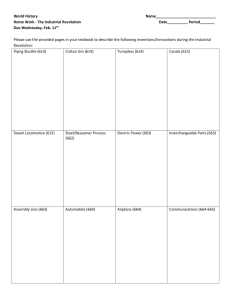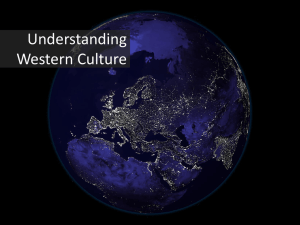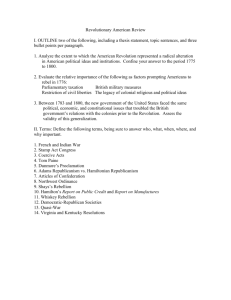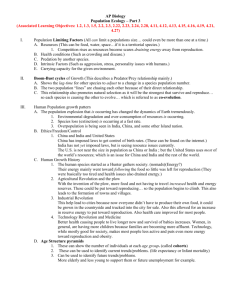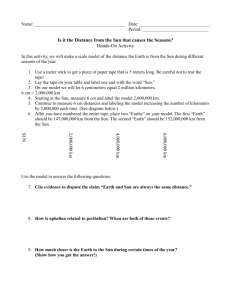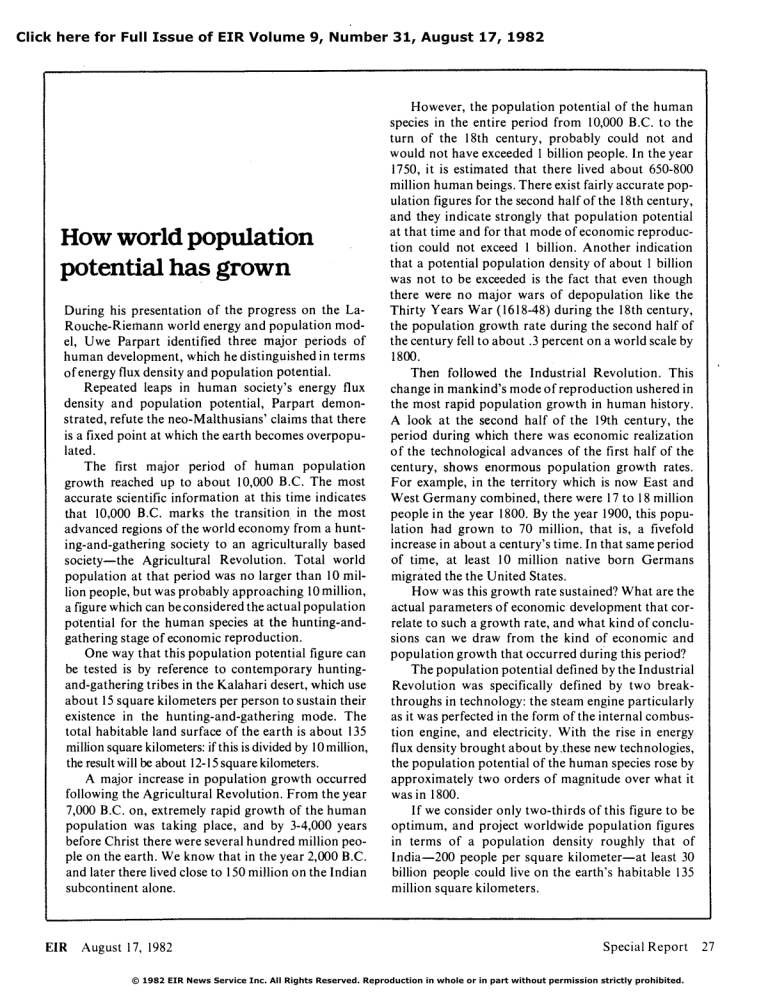
Click here for Full Issue of EIR Volume 9, Number 31, August 17, 1982
However, the population potential of the human
species in the entire period from 10,000 B.C. to the
turn of the 18th century, probably could not and
would not have exceeded I billion people. In the year
1750, it is estimated that there lived about 650-800
million human beings. There exist fairly accurate pop­
ulation figures for the second half of the 18th century,
and they indicate strongly that population potential
How world population
at that time and for that mode of economic reproduc­
potential has grown
that a potential population density of about I billion
tion could not exceed 1 billion. Another indication
was not to be exceeded is the fact that even though
there were no major wars of depopulation like the
During his presentation of the progress on the La­
Thirty Years War (1618-48) during the 18th century,
Rouche-Riemann world energy and population mod­
the population growth rate during the second half of
human development, which he distinguished in terms
1800.
el, Uwe Parpart identified three major periods of
of energy flux density and population potential.
Repeated leaps in human society's energy flux
density and population potential, Parpart demon­
strated, refute the neo-Malthusians' claims that there
is a fixed point at which the earth becomes overpopu­
lated.
The first major period of human population
growth reached up to about 10,000 B.C. The most
accurate scientific information at this time indicates
the century fell to about .3 percent on a world scale by
Then followed the Industrial Revolution. This
change in mankind's mode of reproduction ushered in
the most rapid population growth in human history.
A look at the second half of the 19th century, the
period during which there was economic realization
of the technological advances of the first half of the
century, shows enormous population growth rates.
For example, in the territory which is now East and
West Germany combined, there were 17 to 18 million
that 10,000 B.C. marks the transition in the most
advanced regions of the world economy from a hunt­
lation had grown to 70 million, that is, a fivefold
society-the Agricultural Revolution. Total world
of time, at least 10 million native born Germans
ing-and-gathering society to an agriculturally based
people in the year 1800. By the year 1900, this popu­
increase in about a century's time. In that same period
population at that period was no larger than 10 mil­
migrated the the United States.
a figure which can be considered the actual population
actual parameters of economic development that cor­
gathering stage of economic reproduction.
sions can we draw from the kind of economic and
lion people, but was probably approaching 10 million,
potential for the human species at the hunting-and­
One way that this population potential figure can
How was this growth rate sustained? What are the
relate to such a growth rate, and what kind of conclu­
population growth that occurred during this period?
be tested is by reference to contemporary hunting­
The popUlation potential defined by the Industrial
and-gathering tribes in the Kalahari desert, which use
Revolution was specifically defined by two break­
about 15 square kilometers per person to sustain their
throughs in technology: the steam engine particularly
existence in the hunting-and-gathering mode. The
as it was perfected in the form of the internal combus­
total habitable land surface of the earth is about 135
tion engine, and electricity. With the rise in energy
million square kilometers: if this is divided by 10 million,
the result will be about 12-15 square kilometers.
A major increase in population growth occurred
following the Agricultural Revolution. From the year
flux density brought about by,these new technologies,
the population potential of the human species rose by
approximately two orders of magnitude over what it
was in 1800.
7,000 B.C. on, extremely rapid growth of the human
If we consider only two-thirds of this figure to be
population was taking place, and by 3-4,000 years
optimum, and project worldwide popUlation figures
before Christ there were several hundred million peo­
in terms of a popUlation density roughly that of
ple on the earth. We know that in the year 2,000 B.C.
India-200 people per square kilometer-at least 30
and later there lived close to 150 million on the Indian
billion people could live on the earth's habitable 135
subcontinent alone.
million square kilometers.
EIR
August 17, 1982
Special Report
© 1982 EIR News Service Inc. All Rights Reserved. Reproduction in whole or in part without permission strictly prohibited.
27



